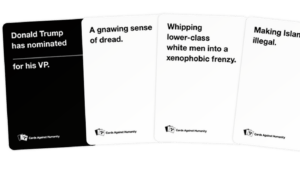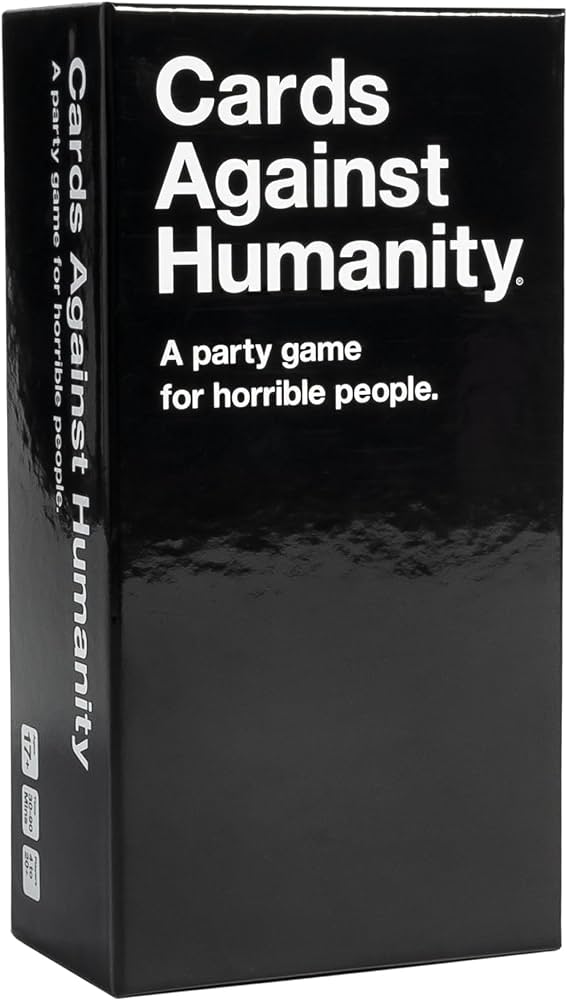Cards Against Humanity is a judging/social game created by Max Temkin, Ben Hantoot, Eliot Weinstein, Daniel Dranove, Eli Halpern, David Pinsof, David Munk, and Josh Dillon. Primarily targeted at groups of friends of high school and above age, this game aims to create enjoyment by forcing players to make funny and inappropriate statements in the hopes of resonating with the humor of a “judge” who can award points for good answers.
The mechanics of Cards Against Humanity are simple. Each player starts with a hand (usually seven) of cards which serve as answers to “fill-in-the-blank” questions. Each round, a different player is selected to be the “judge” and will then draw a question card with a blank. Players will then anonymously select one of the cards in their hand to fill in the question card’s blank, and the judge will choose the answer they thought was the funniest. Then, the person who provided that answer will get a point, all players draw a replacement card from the deck, and play continues. The main dynamic that evolves, and perhaps the way to “win”, is that all players must attempt to satisfy the judge for that round, rather than simply picking cards they think are funny. This intentional choice for the game design aims to get players to think more deeply about the nature of their friends, and not simply the nature of humor, which is more subjective. Since the definition of a “funny” answer varies from person to person, the winner is most likely the one that has the best understanding of what each other person in the group finds funny, rather than one that is just universally funny. There is, however, also an element of randomness inherent in the game: you draw cards at random as your options, rather than hand-picking them, and prompts are randomly chosen each round. This ensures that, even if there are players that are perhaps less familiar with some others in the play group, they don’t feel entirely left out, and still have a chance to win.
Thus, the judging in some sense enables players to learn about each other’s sense of humor better. As rounds go on, as judges reveal their choices, and as players make extraneous comments and observations about the judges’ preferences, all players are enabled to gain a better understanding of at least the judge’s sense of humor. Even more so than that, all players in every round are “judging” the quality of the answers, simply through observing, and hopefully laughing. Watching each other during the rounds, in addition to the judge, and seeing which answers make people laugh, shines a light on the things that each other player finds humorous. Another way in which players learn more about each other is through observing the choices of answers that the others in the group select. Oftentimes, players don’t necessarily play to win – at least in my group, there were several players that, while they did try to satisfy the judge, would often pick answers that they simply found funny, regardless of how optimal it was. Other players would opt for safer answers wherever possible. This second result, in particular, is indicative of another dynamic – players can choose how “safe” they want to be in their answers. Granted, the cards in Cards Against Humanity are specifically chosen such that no answer is “safe” – most answers that fit in a given blank are usually either disgusting, sexual, racist, or in some way non-politically correct.

In a way, though, this lets the group come to sometype of agreement – that is, that no answer provided is to be taken seriously, and the answers, though sometimes revolting or bigoted, should not be taken as the true opinions or preferences of any of the players. In a way, it allows for players to learn more about each other and grow closer to each other by providing a medium that absolutely forces players to make horrible statements, and choose their favorite from a set of horrible statements. By doing this, Cards Against Humanity improves the relationships between players by letting them laugh together in a gamified, “safe” NSFW environment.




